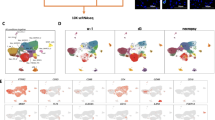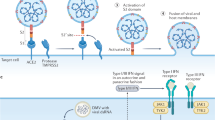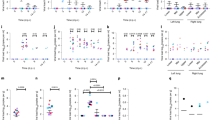Abstract
The primary cause of severe acute respiratory syndrome (SARS) is a newly discovered coronavirus1,2,3,4,5,6,7. Replication of this SARS coronavirus (SCV) occurs mainly in the lower respiratory tract, and causes diffuse alveolar damage2,7,8. Lack of understanding of the pathogenesis of SARS has prevented the rational development of a therapy against this disease. Here we show extensive SCV antigen expression in type 1 pneumocytes of experimentally infected cynomolgus macaques (Macaca fascicularis) at 4 d postinfection (d.p.i.), indicating that this cell type is the primary target for SCV infection early in the disease, and explaining the subsequent pulmonary damage. We also show that prophylactic treatment of SCV-infected macaques with the antiviral agent pegylated interferon-α (IFN-α) significantly reduces viral replication and excretion, viral antigen expression by type 1 pneumocytes and pulmonary damage, compared with untreated macaques. Postexposure treatment with pegylated IFN-α yielded intermediate results. We therefore suggest that pegylated IFN-α protects type 1 pneumocytes from SCV infection, and should be considered a candidate drug for SARS therapy
This is a preview of subscription content, access via your institution
Access options
Subscribe to this journal
Receive 12 print issues and online access
$259.00 per year
only $21.58 per issue
Buy this article
- Purchase on SpringerLink
- Instant access to full article PDF
Prices may be subject to local taxes which are calculated during checkout




Similar content being viewed by others
References
Fouchier, R.A.M. et al. Koch's postulates fulfilled for SARS virus. Nature 423, 240 (2003).
Kuiken, T. et al. Newly discovered coronavirus as the primary cause of severe acute respiratory syndrome. Lancet 362, 263–270 (2003).
Marra, M.A. et al. The genome sequence of the SARS-associated coronavirus. Science 300, 1399–1404 (2003).
Rota, P.A. et al. Characterization of a novel coronavirus associated with severe acute respiratory syndrome. Science 300, 1394–1399 (2003).
Drosten, C. et al. Identification of a novel coronavirus in patients with severe acute respiratory syndrome. N. Engl. J. Med. 348, 1967–1976 (2003).
Ksiazek, T.G. et al. A novel coronavirus associated with severe acute respiratory syndrome. N. Engl. J. Med. 348, 1953–1966 (2003).
Peiris, J.S.M. et al. Coronavirus as a possible cause of severe acute respiratory syndrome. Lancet 361, 1319–1325 (2003).
Tsang, K.W. et al. A cluster of cases of severe acute respiratory syndrome in Hong Kong. N. Engl. J. Med. 348, 1977–1985 (2003).
Lee, N. et al. A major outbreak of severe acute respiratory syndrome in Hong Kong. N. Engl. J. Med. 348, 1986–1994 (2003).
Poutanen, S.M. et al. Identification of severe acute respiratory syndrome in Canada. N. Engl. J. Med. 348, 1995–2005 (2003).
Nicholls, J.M. et al. Lung pathology of fatal severe acute respiratory syndrome. Lancet 361, 1773–1178 (2003).
Ware, L.B. & Matthay, M.A. The acute respiratory distress syndrome. N. Engl. J. Med. 342, 1334–1349 (2000).
Williams, M.C. The alveolar epithelium: structure and study by immunohistochemistry. in Electron Microscopy of the Lung (ed. Schraufnagel, D.E.) 121–147 (Marcel Dekker, New York, 1990).
Bellum, S.C. et al. Respiratory reovirus 1/L induction of intraluminal fibrosis. A model for the study of bronchiolitis obliterans organizing pneumonia. Am. J. Pathol. 150, 2243–2254 (1997).
London, L. et al. Respiratory reovirus 1/L induction of diffuse alveolar damage: pulmonary fibrosis is not modulated by corticosteroids in acute respiratory distress syndrome in mice. Clin. Immunol. 103, 284–295 (2002).
Pei, J., Sekellick, M.J., Marcus, P.I., Choi, I.S. & Collisson, E.W. Chicken interferon type I inhibits infectious bronchitis virus replication and associated respiratory illness. J. Interferon Cytokine Res. 21, 1071–1077 (2001).
Smith, A.L., Barthold, S.W. & Beck, D.S. Intranasally administered α/β interferon prevents extension of mouse hepatitis virus, strain JHM, into the brains of BALB/cByJ mice Ant. Res. 8, 239–245 (1987).
Turner, R.B., Felton, A., Kosak, K., Kelsey, D.K. & Meschievitz, C.K. Prevention of experimental coronavirus colds with intranasal α-2b interferon. J. Infect. Dis. 154, 443–447 (1986).
Manns, M.P. et al. Peginterferon α-2b plus ribavirin compared with interferon α-2b plus ribavirin for initial treatment of chronic hepatitis C: a randomised trial. Lancet 358, 958–965 (2001).
Cinatl, J. et al. Treatment of SARS with human interferons. Lancet 362, 293–294 (2003).
Bukowski, R.M. et al. Treating cancer with PEG Intron: pharmacokinetic profile and dosing guidelines for an improved interferon-α2b formulation. Cancer 95, 389–396 (2002).
Van Gool, A.R. et al. Serum amino acids, biopterin and neopterin during long-term immunotherapy with interferon-α in high-risk melanoma patients. Psychiatry Res. 119, 125–132 (2003).
Franks, T.J. et al. Lung pathology of severe acute respiratory syndrome (SARS): a study of 8 autopsy cases from Singapore. Hum. Pathol. 34, 743–748 (2003).
Bedrossian, C.W., Sussman, J., Conklin, R.H. & Kahan, B. Azathioprine-associated interstitial pneumonitis. Am. J. Clin. Path. 82, 148–154 (1984).
Biron, C.A. Interferons α and β as immune regulators: a new look. Immunity 14, 661–664 (2001).
Finter, N.B. & Oldham, R.K. (eds.) Interferons: In Vivo and Clinical Studies. Vol. 4 (Elsevier, Amsterdam, 1985).
Booth, C.M. et al. Clinical features and short-term outcomes of 144 patients with SARS in the greater Toronto area. JAMA 289, 2801–2809 (2003).
Peiris, J.S.M. et al. Clinical progression and viral load in a community outbreak of coronavirus-associated SARS pneumonia: a prospective study. Lancet 361, 1767–1772 (2003).
Fouchier, R.A. et al. Detection of influenza viruses from different species by PCR amplification of conserved sequences in the matrix gene. J. Clin. Microbiol. 38, 4096–5001 (2000).
Acknowledgements
We thank S. Bruijns, J.M. Vrolijk, G. Aron, F. van der Panne, R. Dias d'Ullois and D. Fekkes for assistance, and J.D. Laman for advice on immunohistochemistry.
Author information
Authors and Affiliations
Corresponding author
Ethics declarations
Competing interests
The authors declare no competing financial interests.
Rights and permissions
About this article
Cite this article
Haagmans, B., Kuiken, T., Martina, B. et al. Pegylated interferon-α protects type 1 pneumocytes against SARS coronavirus infection in macaques. Nat Med 10, 290–293 (2004). https://doi.org/10.1038/nm1001
Received:
Accepted:
Published:
Issue date:
DOI: https://doi.org/10.1038/nm1001
This article is cited by
-
Eigenvalue analysis of SARS-CoV-2 viral load data: illustration for eight COVID-19 patients
International Journal of Data Science and Analytics (2023)
-
A suspicious role of interferon in the pathogenesis of SARS-CoV-2 by enhancing expression of ACE2
Signal Transduction and Targeted Therapy (2020)
-
Considering how biological sex impacts immune responses and COVID-19 outcomes
Nature Reviews Immunology (2020)
-
What are the drugs having potential against COVID-19?
Medicinal Chemistry Research (2020)
-
Puzzle of highly pathogenic human coronaviruses (2019-nCoV)
Protein & Cell (2020)



